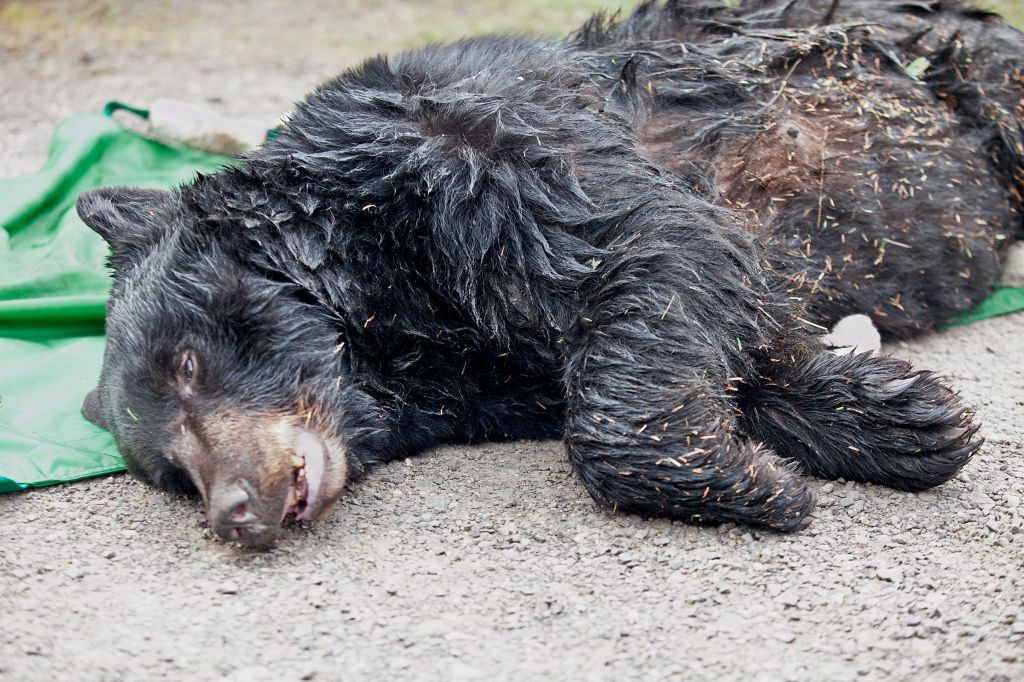It’s raining bears Bruin family relocated after tranquilizer darting
Published 10:09 am Monday, November 24, 2014

- NATALIE ST. JOHN/nstjohn@chinookobserver.com The sedated sow slumbered on a tarp while WDFW officers prepared a cage with straw bedding and water. She and her two cubs were released in the Olympic National Forest.
ILWACO — A mama bear and her two cubs went looking for some tasty garbage last Wednesday morning, and ended up having what was certainly the worst day of their lives. Hours after a tiny dog chased them into a tree, the soaking wet, groggy and sore bears woke up in a cage that was speeding up the highway toward their new home.
Residents at the Safari RV Park in Ilwaco alerted the Washington Department of Fish and Wildlife that three bears had taken refuge in the top of a hemlock tree near the front of the park. When the bears still hadn’t come down after several hours, WDFW game wardens used tranquilizers to get the bears out of the tree, then moved them north to the Olympic National Forest.
Thursday morning, Sgt. Dan Chadwick explained that officers believed relocating the bears was the best way to prevent any further human-bear encounters at Safari.
“They were in a fenced in area at an RV park. If they came out of the tree, we didn’t know where their escape route was. We felt with the amount of homes in the area, it would be likely they would be run up another tree and we would keep dealing with the same situation,” Chadwick said. Officers were also concerned that the distressed bears might get separated from one another if they tried to escape, Chadwick said. The WDFW doesn’t always relocate bears — single adults who show signs of being overly dependent on humans are often euthanized. But Chadwick said relocation made sense in this case, because the whole family was present.
Safari resident Diane DeSeranno said her son, who lives next door, first noticed the trio of bears around 7:30 a.m. when his dog suddenly started barking frantically. When he opened the door to see what had caused the commotion, the dog dashed outside. The tiny dog scared the cubs so badly that they ran up the trunk of a pine tree next to DeSeranno’s shed.
“He grabbed his robe, and barefoot and all, went out to get his dog and saw them,” DeSeranno said. “By that time the cubs had already been treed. They went up, but Mama Bear was on the ground.”
The sow soon followed her cubs to a height of about 25 feet, and there they stayed.
At first, WDFW Officer Paul Jacobson waited in his truck, hoping the bears would come down on their own. But with dogs nearby dogs barking and residents coming to take photos, the distressed mother showed no signs of budging.
At 11 a.m., the two cubs were huddled together a few feet above their mother on a set of branches that stretched out over a small pond. Ever protective of her children, the sow pawed, panted and grunted whenever an onlooker drew too close for her comfort.
Citing concerns about both the bears’ health and the residents’ safety, Jacobson decided it would be best to tranquilize the bears. However, the WDFW only has one tranquilizer gun, and the officer who had it was in the Seattle area, so it took until about 1:30 p.m. to gather the necessary staff and gear.
While he waited for his colleagues to arrive, Jacobson explained that the park’s four giant trash cans full of food waste probably created an overwhelming temptation for the bears. He emphasized the importance of securely storing pet food, trash and bird feeders, saying that at this point in the year, the only bears that haven’t “denned” yet are those with access to a human-provided food source.
“There aren’t problem bears, there are problem people,” Jacobson said.
When the officers got started, it was easy for Officer Bruce Richards to sedate the agitated sow with a tranquilizer dart. But when the sedatives kicked in, the roughly 260-pound bear missed the nets officers had spread around the base of the tree, splashing into the shallow pond instead. After giving her a cursory examination, officers lugged her into a hay-filled cage, and gave her additional sedatives to ensure that she would sleep until she was reunited with her cubs.
Next, Richards climbed onto DeSeranno’s shed — the only place where he had an angle on the first of the two cubs, and fired off a pink-tufted dart.
Below, the other officers listened to Richards’ repeated warnings not to let the cub hit the ground and waited with outstretched nets for the bear to fall. After several minutes, the bear began to lick its lips. Its head drooped, its muscles went limp, and finally, it tumbled through the branches, missing the nets entirely and belly-flopping into the pond with a colossal splash.
An officer quickly jumped into the pond and hustled the dripping, limp body onto the net. From there, she was hauled to the road by the scruff of her neck, weighed, ear-tagged, and placed in the cage with her unconscious mother.
The second cub gave a little yelp when Richards struck it with a tranquilizer dart, but refused to fall asleep. By then, Richards was out of darts, so his colleagues eventually decided to tie a safety rope to his waist and guide him up the tree. Carrying a syringe, Richards climbed until he said he was “eyeball to eyeball” with the little cub, and then gave it a second dose.
Again, minutes passed while Richards waited on his tenuous perch for the bear to show signs of sedation. Finally, after exhorting the men down below to get ready, he gave the cub a gentle push. It fell only a few feet before clinging fiercely to a lower section of trunk. Twice more, Richards prodded, before the little bear finally let go and fell headlong into the pond. He too was hustled out of the pond within seconds, and placed inside the cage. Richards descended with bloodied arms.
DeSeranno and her neighbors watched the procedure with intense interest, photographing the cubs as they slept on a tarp, and creeping closer to the cage to peer inside. It was exciting, DeSeranno said — something a civilian might never see.
During her 18 years at Safari, DeSeranno has seen bears “off and on,” but residents have seen them in the park more frequently this year.
“My only feeling is, years ago, we moved in on their territory. They’re still living here, obviously. We get deer walking through the park, too,” DeSeranno said.
Biologist Scott Harris said the sow appeared to be older but in good health. The cubs — both female, each weighed around 90 pounds, and were about a year old.
According to Harris, the mother appeared to be dependent on human garbage, but wasn’t dangerously habituated to humans. The WDFW tries to avoid euthanizing sows that are caring for cubs, so she’ll be relocated, too. Once she’s released, her chances of survival depend on whether she’s able find food for herself in the wild.
“She’ll probably have a hard winter,” Harris said. The two cubs also appeared to be healthy, and capable of learning how to fend for themselves. As young as they are, they have quite good chances of thriving in their new home, Harris said.
Thursday, Chadwick said WDFW officers observed to be sure the bears regained consciousness and did not show any signs of illness or injury,
“They all came out of sedation fine. They were released a little groggy, but they all took off fine,” Chadwick said.





